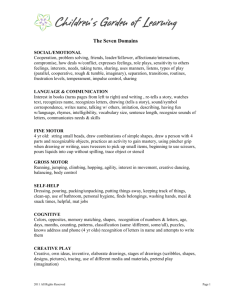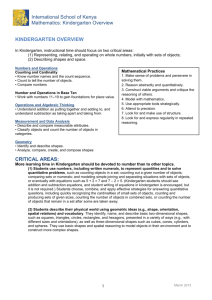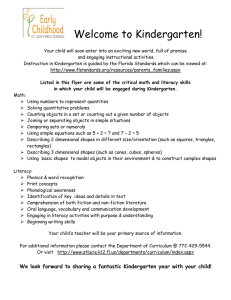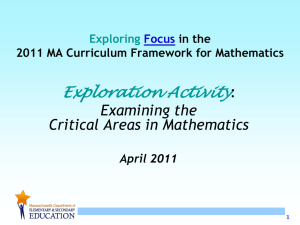GENERIC EVALUATION CRITERIA
advertisement
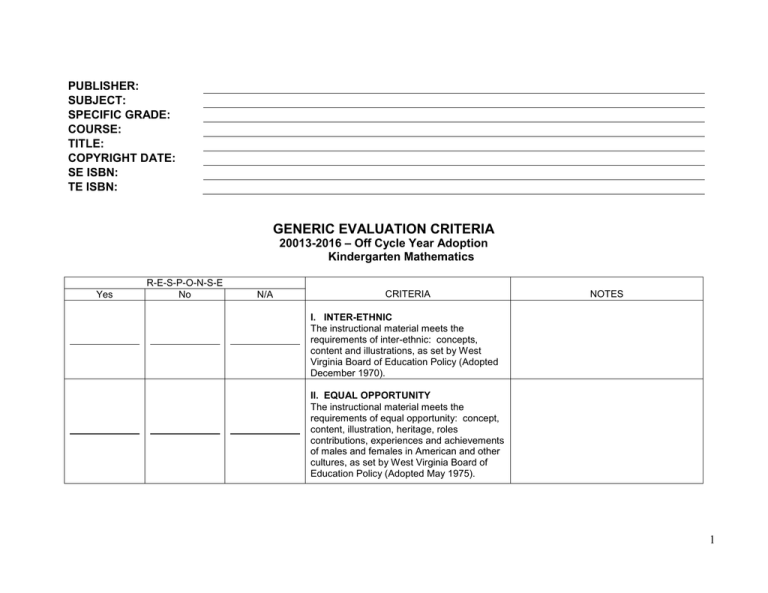
PUBLISHER: SUBJECT: SPECIFIC GRADE: COURSE: TITLE: COPYRIGHT DATE: SE ISBN: TE ISBN: GENERIC EVALUATION CRITERIA 20013-2016 – Off Cycle Year Adoption Kindergarten Mathematics Yes R-E-S-P-O-N-S-E No N/A CRITERIA NOTES I. INTER-ETHNIC The instructional material meets the requirements of inter-ethnic: concepts, content and illustrations, as set by West Virginia Board of Education Policy (Adopted December 1970). II. EQUAL OPPORTUNITY The instructional material meets the requirements of equal opportunity: concept, content, illustration, heritage, roles contributions, experiences and achievements of males and females in American and other cultures, as set by West Virginia Board of Education Policy (Adopted May 1975). 1 III. FORMAT The resource is available as an option for adoption in an interactive electronic format. INSTRUCTIONAL MATERIALS ADOPTION: 21st CENTURY LEARNING EVALUATION CRITERIA GENERAL EVALUATION CRITERIA 20013-2016 – Off Cycle Year Adoption Kindergarten Mathematics INSTRUCTIONAL MATERIALS ADOPTION: GENERAL EVALUATION CRITERIA The general evaluation criteria apply to each grade level and are to be evaluated for each grade level unless otherwise specified. These criteria consist of information critical to the development of all grade levels. In reading the general evaluation criteria and subsequent specific grade level criteria, e.g. means “examples of” and i.e. means that “each of” those items must be addressed. Eighty percent of the general criteria must be met with I (In-depth) or A (Adequate) in order to be recommended. 2 (Vendor/Publisher) SPECIFIC LOCATION OF CONTENT WITHIN PRODUCT (IMR Committee) Responses I=In-depth A=Adequate M=Minimal N=Nonexistent I A M N For student mastery of content standards and objectives, the instructional materials will provide students with the opportunity to apply: A. MATHEMATICAL PRACTICES 1. Make sense of problems and persevere in solving them. Explain to themselves the meaning of a problem and looking for entry points to its solution. Analyze givens, constraints, relationships, and goals Make conjectures about the form and meaning of the solution attempt. Plan a solution pathway rather than simply jumping into a solution. Consider analogous problems and try special cases and simpler forms of insight into its solution. Monitor and evaluate their progress and change course if necessary. Transform algebraic expressions or change the viewing window on their graphing calculator to get information. Explain correspondences between equations, verbal descriptions, tables, and graphs. Draw diagrams of important features and relationships, graph data, and search for regularity or trends. Use concrete objects or pictures to help conceptualize and solve a problem. Check their answers to problems using a different method. Ask themselves, “Does this make sense?” Understand the approaches of others to solving complex 3 problems and identify correspondences between approaches. 2. Reason abstractly and quantitatively. Make sense of quantities and their relationships in problem situations. Bring two complementary abilities to bear on problems involving quantitative relationships: o Decontextualize (abstract a given situation and represent it symbolically and manipulate the representing symbols as if they have a life of their own, without necessarily attending to their referents and o Contextualize (pause as needed during the manipulation process in order to probe into the referents for the symbols involved). Use quantitative reasoning that entails creating a coherent representation of the problem at hand, considering the units involved, and attending to the meaning of quantities, not just how to compute them Know and flexibly use different properties of operations and objects. 3. Construct viable arguments and critique the reasoning of others. Understand and use stated assumptions, definitions, and previously established results in constructing arguments. Make conjectures and build a logical progression of statements to explore the truth of their conjectures. Analyze situations by breaking them into cases Recognize and use counterexamples. Justify their conclusions, communicate them to others, and respond to the arguments of others. Reason inductively about data, making plausible arguments that take into account the context from which the data arose. Compare the effectiveness of plausible arguments. Distinguish correct logic or reasoning from that which is flawed 4 and, if there is a flaw, explain what it is o Elementary students construct arguments using concrete referents such as objects, drawings, diagrams, and actions. o Later students learn to determine domains to which an argument applies. Listen or read the arguments of others, decide whether they make sense, and ask useful question to clarify or improve arguments. 4. Model with mathematics. Apply the mathematics they know to solve problems arising in everyday life, society, and the workplace. o In early grades, this might be as simple as writing an addition equation to describe a situation. In middle grades, a student might apply proportional reasoning to plan a school event or analyze a problem in the community. o By high school, a student might use geometry to solve a design problem or use a function to describe how one quantity of interest depends on another. Make assumptions and approximations to simplify a complicated situation, realizing that these may need revision later. Identify important quantities in a practical situation Map their relationships using such tools as diagrams, two-way tables, graphs, flowcharts and formulas. Analyze those relationships mathematically to draw conclusions. Interpret their mathematical results in the context of the situation. Reflect on whether the results make sense, possibly improving the model if it has not served its purpose. 5. Use appropriate tools strategically. Consider available tools when solving a mathematical problem. (these tools might include pencil and paper, concrete models, a ruler, protractor, calculator, spreadsheet, computer algebra system, a statistical package, or dynamic geometry software. 5 Are sufficiently familiar with tools appropriate for their grade or course to make sound decisions about when each of these tools might be helpful, recognizing both the insight to be gained and their limitations. o High school students analyze graphs of functions and solutions generated using a graphing calculator Detect possible errors by using estimations and other mathematical knowledge. Know that technology can enable them to visualize the results of varying assumptions, explore consequences, and compare predictions with data. Identify relevant mathematical resources and use them to pose or solve problems. Use technological tools to explore and deepen their understanding of concepts. 6. Attend to precision. Try to communicate precisely to others. Try to use clear definitions in discussion with others and in their own reasoning. State the meaning of the symbols they choose, including using the equal sign consistently and appropriately. Specify units of measure and label axes to clarify the correspondence with quantities in a problem. Calculate accurately and efficiently, express numerical answers with a degree of precision appropriate for the problem context. o In the elementary grades, students give carefully formulated explanations to each other. o In high school, students have learned to examine claims and make explicit use of definitions. 7. Look for and make use of structure. Look closely to discern a pattern or structure. o Young students might notice that three and seven more is the same amount as seven and three more or they may sort a 6 collection of shapes according to how many sides the shapes have. o Later, students will see 7 x 8 equals the well remembered 7 x 5 + 7 x 3, in preparation for the distributive property. o In the expression x2 + 9x + 14, older students can see the 14 as 2 x 7 and the 9 as 2 + 7. They recognize the significance of an existing line in a geometric figure and can use the strategy of drawing an auxiliary line for solving problems. Step back for an overview and can shift perspective. See complicated things, such as some algebraic expressions, as single objects or composed of several objects. 8. Look for and express regularity in repeated reasoning. Notice if calculations are repeated. Look both for general methods and for shortcuts. o Upper elementary students might notice when dividing 25 by 11 that they are repeating the same calculations over and over again, and conclude they have a repeated decimal. o Middle school students might abstract the equation (y-2)/((x-1)=3 by paying attention to the calculation of slope as they repeatedly check whether the points are on the line through (1,2) with a slope 3. o Noticing the regularity in the way terms cancel when expanding (x-1)(x+1)(x2+1) and (x-1)(x3+x2+x+1) might lead high school students to the general formula for the sum of a geometric series. Maintain oversight of the process of solving a problem, while attending to the details. Continually evaluate the reasonableness of intermediate results. 7 SPECIFIC EVALUATION CRITERIA 20013-2016 – Off Cycle Year Adoption Kindergarten Mathematics In Kindergarten, instructional time should focus on two critical areas: (1) representing and comparing whole numbers, initially with sets of objects; (2) describing shapes and space. More learning time in Kindergarten should be devoted to number than to other topics. 1. Students use numbers, including written numerals, to represent quantities and to solve quantitative problems, such as counting objects in a set; counting out a given number of objects; comparing sets or numerals; and modeling simple joining and separating situations with sets of objects, or eventually with equations such as 5 + 2 = 7 and 7 – 2 = 5. (Kindergarten students should see addition and subtraction equations, and student writing of equations in kindergarten is encouraged, but it is not required.) Students choose, combine and apply effective strategies for answering quantitative questions, including quickly recognizing the cardinalities of small sets of objects, counting and producing sets of given sizes, counting the number of objects in combined sets or counting the number of objects that remain in a set after some are taken away. 2. Students describe their physical world using geometric ideas (e.g., shape, orientation, spatial relations) and vocabulary. They identify, name and describe basic two-dimensional shapes, such as squares, triangles, circles, rectangles and hexagons, presented in a variety of ways (e.g., with different sizes and orientations), as well as three-dimensional shapes such as cubes, cones, cylinders and spheres. They use basic shapes and spatial reasoning to model objects in their environment and to construct more complex shapes. 8 (IMR Committee) Responses (Vendor/Publisher) SPECIFIC LOCATION OF CONTENT WITHIN PRODUCT I=In-depth A=Adequate M=Mi nimal N=Nonexistent I A M N For student mastery of content standards and objectives, the instructional materials will provide students with the opportunity to A. Counting and Cardinality Know Number Names and Count Sequence 1. Count to 100 by ones and by tens. 2. Count forward beginning from a given number within the known sequence. 3. Write number from 0 to 20. Represent a number of objects with a written numeral 0-20. Count to Tell the Number of Objects 4. Understand the relationship between numbers and quantities; connect counting to cardinality When counting objects, say the number names in the standard order, pairing each object with one and only one number name and each number name with one and only one object, Understand that the last number name said tells the number of objects counted and the number of objects is the same regardless of their arrangement or the order in which they were counted, Understand that each successive number name refers to a quantity that is one larger. 9 5. Count to answer “how many?” Questions about as many as 20 things arranged in a line, a rectangular array, a circle, or as many as 10 things in a scattered configuration; given a number from 1– 20, count out that many objects. Compare numbers 6. Identify whether the number of objects in one group is greater than, less than, or equal to the number of objects in another group, e.g., by using matching and counting strategies. 7. Compare two numbers between 1 and 10 presented as written numerals. B. Operations & Algebraic Thinking Understand addition as putting together and adding to, and understand subtraction as taking apart and taking from. 1. Represent addition and subtraction with objects, fingers, mental images, drawings, sounds (e.g., claps), acting out situations, verbal explanations, expressions or equations. 2. Solve addition and subtraction word problems and add and subtract within 10, e.g., by using objects or drawings to represent the problem. 3. Decompose numbers less than or equal to 10 into pairs in more than one way, e.g., by using objects or drawings, and record each decomposition by a drawing or equation (e.g., 5 = 2 + 3 and 5 = 4 + 1). 4. For any number from 1 to 9, find the number that makes 10 when added to the given number, e.g., by using objects or drawings, and record the answer with a drawing or equation. 5. Fluently add and subtract within 5. 10 C. Number & Operations in Base Ten Work with numbers 11-19 to gain foundations for place value. 1. Compose and decompose numbers from 11 to 19 into ten ones and some further ones, e.g., by using objects or drawings, and record each composition or decomposition by a drawing or equation, e.g., 18 = 10 + 8; understand that these numbers are composed of ten ones and one, two, three, four, five, six, seven, eight, or nine ones. D. Measurement & Data Describe and compare measurable attributes. 1. describe measurable attributes of objects, such as length or weight and describe several measurable attributes of a single object. 2. directly compare two objects with a measurable attribute in common, to see which object has “more of”/“less of” the attribute , and describe the difference. For example, directly compare the heights of two children and describe one child as taller/shorter. Classify objects and count the number of objects in each category. 3. classify objects into given categories, count the numbers of objects in each category, and sort the categories by count. Category counts should be limited to less than or equal to 10. E. Geometry Identify and Describe Shapes (squares, circles, triangles, rectangles, hexagons, cubes, cones, cylinders and spheres) 1. describe objects in the environment using names of shapes and describe the relative positions of these objects using terms such as above, below, beside, in front of, behind and next to. 11 2. correctly name shapes regardless of their orientations or overall size. 3. identify shapes as two-dimensional (lying in a plane, “flat”) or threedimensional (“solid”). Analyze, Compare, Create and Compose Shapes 4. Analyze and compare two- and three-dimensional shapes, in different sizes and orientations, using informal language to describe their similarities, differences, parts (e.g., number of sides and vertices/“corners”) and other attributes (e.g., having sides of equal length). 5. Model shapes in the world by building shapes from components (e.g., sticks and clay balls) and drawing shapes. 6. Compose simple shapes to form larger shapes. For example, “can you join these two triangles with full sides touching to make a rectangle?” 12
